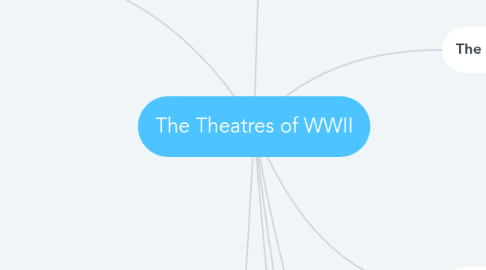
1. Dates
1.1. September 1, 1939
1.1.1. Germany invaded Poland
1.2. 1941
1.2.1. Atlantic charter
1.2.1.1. Signed by UK's Churchill and US's FDR
1.2.1.2. Promise to not gain anymore land after WWII
1.3. December 7, 1941
1.3.1. Attack on Pearl Harbor
1.3.2. Catalyst that brought US into WWII
1.4. 1942
1.4.1. Battle of Midway
1.4.1.1. Between US and Japan
1.4.1.2. US Naval victory
1.4.1.3. Marked a turning point in the war
1.5. June 10, 1942
1.5.1. Battle of Britain
1.5.1.1. Hitler ordered air attack
1.5.1.2. Churchill ordered bomb raids in Berlin
1.5.1.3. Canada assisted UK
1.6. July 1942
1.6.1. Allied invasion of North Africa
1.7. June 6, 1944
1.7.1. D-Day
1.7.1.1. 160,000 allied troops landed in France
1.7.1.2. Fought Germany in Normandy
1.7.1.3. More than 5,000 ships and 13,000 aircrafts supported allies
1.7.1.4. Forced allies to split and fight on two fronts
1.7.2. Operation Overlord
1.8. April 1, 1945
1.8.1. US invaded Okinawa
1.8.2. US island hopped to Japan
1.9. May 8, 1945
1.9.1. V-E Day
1.9.1.1. Day when Germans surrendered
1.9.1.2. Victory over Europe
1.10. August 6, 1945
1.10.1. First atomic bomb dropped
1.10.2. Hiroshima, Japan
1.11. August 15, 1945
1.11.1. V-J Day
1.11.1.1. Day when Japan surrendered
1.11.1.2. Victory over Japan
1.12. December 1944-January 1945
1.12.1. Battle of the Bulge
2. Major places WWII was fought
2.1. Eastern front
2.1.1. Between Nazi Germany and Soviet Union
2.1.1.1. Non-Aggression pact
2.1.1.1.1. SU and Germany promised not to attack each other
2.2. Pacific
2.2.1. USA and Japan conflict
2.2.1.1. Battle of Midway
2.2.1.1.1. turning point in war
2.2.1.2. Bataan Death March
2.2.1.2.1. Japanese forced 60,000 Americans and Philippines to march 100 miles with no food and water
2.2.1.3. Battle of Coral Sea
2.2.1.3.1. A battle between Japanese and American naval forces that stopped the Japanese advance on Australia
2.2.1.3.2. Battle fought totally by airpower
2.2.1.3.3. naval ships never came within sight of each other
2.2.1.4. Oil embargo for Japans aggression
2.3. Western front
2.3.1. UK, US, and Nazi Germany conflict
2.3.1.1. D-Day
3. The Big 3
3.1. Winston Churchill
3.1.1. UK
3.2. Franklin D. Roosevelt
3.2.1. USA
3.3. Joseph Stalin
3.3.1. USSR
3.4. Met between 1943-1945 to coordinate attacks
3.5. Met to discuss postwar plans too
4. Axis Powers
4.1. Germany
4.2. Italy
4.3. Japan
4.3.1. Kamikaze
4.3.1.1. Suicide fighter pilots
4.3.2. Hiroshima & Nagasaki
4.3.2.1. Atomic bombs dropped
4.3.3. Okinawa
4.3.3.1. Invaded by US
4.3.4. Iwo Jima
4.3.4.1. Showed Japan was going to fight to the death
4.3.4.2. One of the bloodiest battles in WWII
5. Allied Powers
5.1. United Kingdom
5.1.1. Battle of Britain
5.2. United States
5.2.1. Manhatten Project
5.2.1.1. Secret project of building the Atomic Bombs
5.2.2. FDR
5.2.2.1. President
5.2.2.2. Died during the war
5.2.3. Truman
5.2.3.1. Succeeded FDR
5.2.3.2. Ordered the bombs to be dropped
5.2.4. Douglas McArthur
5.2.4.1. American General
5.2.4.2. commanded allied troops in Pacific
5.3. France
5.3.1. D-Day fought in Normandy, France
5.4. Soviet Union
5.4.1. European Theatre with the highest casualties
6. Theatres
6.1. Pacific Theatre
6.1.1. Jungle Warfare
6.2. European Theatre
6.2.1. Urban warfare
7. Atomic bombs
7.1. Hiroshima
7.1.1. First bomb dropped
7.2. Nagasaki
7.2.1. second bomb dropped
7.3. Harry S. Truman
7.3.1. Became President after FDR died
7.3.2. Ordered the atomic bombs to be dropped
7.3.2.1. Trumans reason was to save American lives
